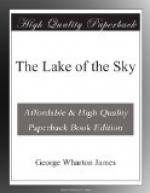the Lake at its southwestern end. And,
since the mountain slopes here are toward the northeast
and therefore the shadiest and coolest, here also
the glaciers have had the greatest vitality and
lived the longest, and have, therefore, left the
plainest records. Doubtless, careful examination
would discover the pathways of glaciers running into
the Lake from the eastern summit also; but I failed
to detect any very clear traces of such, either
on the eastern or on the northern portion of the
western side of the Lake; while between the southwestern
end and Sugar Pine Point, a distance of only eight
or ten miles, I saw distinctly the pathways of five
or six. North of Sugar Pine Point there are also
several. They are all marked by moraine ridges
running down from the summits and projecting as
points into the Lake. The pathways of
three of these glaciers I studied somewhat carefully,
and after a few preliminary remarks, will describe
in some detail.
Mountains are the culminating points of the scenic grandeur and beauty of the earth. They are so, because they are also the culminating points of all geological agencies—igneous agencies in mountain formation, aqueous agencies in mountain sculpture. Now, I have already said that the mountain peaks which stand above the Lake on every side are highest at the southwestern end, where they rise to the altitude of 3000 feet above the lake surface, or between 9000 and 10,000 feet above the sea. Here, therefore, ran in the greatest glaciers; here we find the profoundest glacial sculpturings; and here also are clustered all the finest beauties of this the most beautiful of mountain lakes. I need only name Mount Tallac, Fallen Leaf Lake, Cascade Lake, and Emerald Bay, all within three or four miles of each other and of the Tallac House. These three exquisite little lakes (for Emerald Bay is also almost a lake), nestled closely against the loftiest peaks of the western summit ridge, are all perfect examples of glacial lakes.
South of Lake Tahoe, Lake Valley extends for fifteen miles as a plain, gently rising southward. At its lower end it is but a few feet above the lake surface, covered with glacial drift modified by water, and diversified, especially on its western side, by debris ridges, the moraines of glaciers which continued to flow into the valley or into the Lake long after the main glacier, of which they were once tributaries, had dried up. On approaching the south end of the Lake by steamer, I had observed these long ridges, divined their meaning, and determined on a closer acquaintance. While staying at the Tallac House I repeatedly visited them and explored the canyons down which their materials were brought. I proceed to describe them.
Fallen Leaf Lake Glacier. Fallen Leaf Lake lies on the plain of Lake Valley, about one and a half miles from Lake Tahoe, its surface but a few feet above the level of the latter Lake[2];




